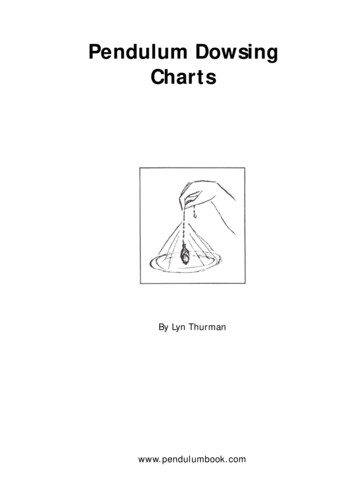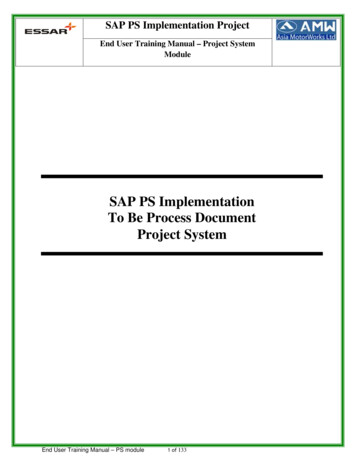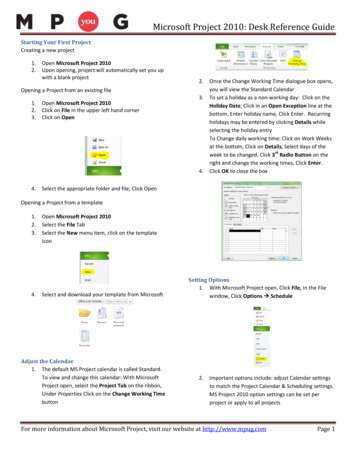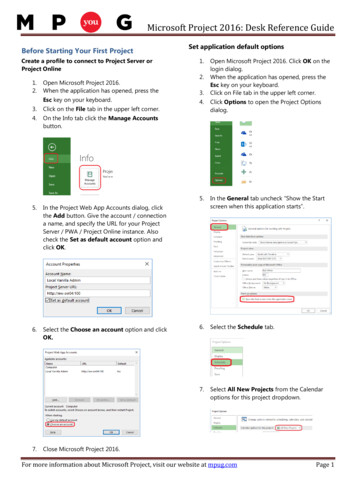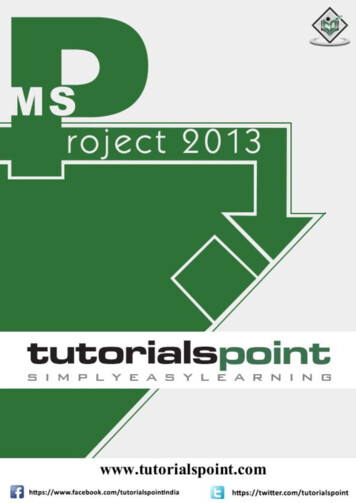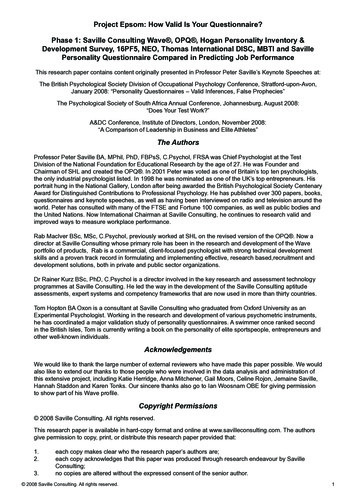
Transcription
Project Epsom: How Valid Is Your Questionnaire?Phase 1: Saville Consulting Wave , OPQ , Hogan Personality Inventory &Development Survey, 16PF5, NEO, Thomas International DISC, MBTI and SavillePersonality Questionnaire Compared in Predicting Job PerformanceThis research paper contains content originally presented in Professor Peter Saville’s Keynote Speeches at:The British Psychological Society Division of Occupational Psychology Conference, Stratford-upon-Avon,January 2008: “Personality Questionnaires – Valid Inferences, False Prophecies”The Psychological Society of South Africa Annual Conference, Johannesburg, August 2008:“Does Your Test Work?”A&DC Conference, Institute of Directors, London, November 2008:“A Comparison of Leadership in Business and Elite Athletes”The AuthorsProfessor Peter Saville BA, MPhil, PhD, FBPsS, C.Psychol, FRSA was Chief Psychologist at the TestDivision of the National Foundation for Educational Research by the age of 27. He was Founder andChairman of SHL and created the OPQ . In 2001 Peter was voted as one of Britain’s top ten psychologists,the only industrial psychologist listed. In 1998 he was nominated as one of the UK’s top entrepreneurs. Hisportrait hung in the National Gallery, London after being awarded the British Psychological Society CentenaryAward for Distinguished Contributions to Professional Psychology. He has published over 300 papers, books,questionnaires and keynote speeches, as well as having been interviewed on radio and television around theworld. Peter has consulted with many of the FTSE and Fortune 100 companies, as well as public bodies andthe United Nations. Now International Chairman at Saville Consulting, he continues to research valid andimproved ways to measure workplace performance.Rab MacIver BSc, MSc, C.Psychol, previously worked at SHL on the revised version of the OPQ . Now adirector at Saville Consulting whose primary role has been in the research and development of the Waveportfolio of products, Rab is a commercial, client-focused psychologist with strong technical developmentskills and a proven track record in formulating and implementing effective, research based,recruitment anddevelopment solutions, both in private and public sector organizations.Dr Rainer Kurz BSc, PhD, C.Psychol is a director involved in the key research and assessment technologyprogrammes at Saville Consulting. He led the way in the development of the Saville Consulting aptitudeassessments, expert systems and competency frameworks that are now used in more than thirty countries.Tom Hopton BA Oxon is a consultant at Saville Consulting who graduated from Oxford University as anExperimental Psychologist. Working in the research and development of various psychometric instruments,he has coordinated a major validation study of personality questionnaires. A swimmer once ranked secondin the British Isles, Tom is currently writing a book on the personality of elite sportspeople, entrepreneurs andother well-known individuals.AcknowledgementsWe would like to thank the large number of external reviewers who have made this paper possible. We wouldalso like to extend our thanks to those people who were involved in the data analysis and administration ofthis extensive project, including Katie Herridge, Anna Mitchener, Gail Moors, Celine Rojon, Jemaine Saville,Hannah Staddon and Karen Tonks. Our sincere thanks also go to Ian Woosnam OBE for giving permissionto show part of his Wave profile.Copyright Permissions 2008 Saville Consulting. All rights reserved.This research paper is available in hard-copy format and online at www.savilleconsulting.com. The authorsgive permission to copy, print, or distribute this research paper provided that:1.each copy makes clear who the research paper’s authors are;2. each copy acknowledges that this paper was produced through research endeavour by SavilleConsulting;3.no copies are altered without the expressed consent of the senior author. 2008 Saville Consulting. All rights reserved.1
Project Epsom: How Valid Is Your Questionnaire?AbstractA major research initiative, Project Epsom, compared the validities of a range of the most popular personalityquestionnaires using the same sample and the same work performance measures. In this study theSaville Consulting Wave Professional Styles was the most valid questionnaire in terms of measuring jobperformance. The questionnaires compared were validated against the externally-developed SHL GreatEight competency framework (Kurz & Bartram, 2002) and a global performance measure, in order to ensurefairness of comparison and to avoid bias towards the Saville Consulting questionnaires. Great care wastaken in the use of these work performance criteria and the equations for predicting work performancepublished by Bartram (2005) were utilized for the Occupational Personality Questionnaire (OPQ ).The questionnaires were also compared to other models of work performance, including the extensiveSaville Consulting model of work effectiveness (Kurz et al., 2009). Against this model, the Saville Consultingquestionnaires performed better still, but for the purposes of this paper these results are not presented here.The Saville Consulting Wave Professional Styles questionnaire therefore outperformed the OPQ against itsown model of work effectiveness.The newly-developed Saville Personality Questionnaire (Saville PQ ; Saville et al., 2008a) also performedas well, if not better than the OPQ and many other established questionnaires. The Saville PQ wasdeveloped using the same approach as the OPQ , takes under 15 minutes to gather both normative andipsative responses and makes a crucial distinction between a person’s talents and motivations. Many of theother questionnaires compared in Project Epsom did show at least a moderate level of validity in measuringjob performance.In considering the results from this research, the present paper also provides an initial orientation in the keyconcepts surrounding personality questionnaires and offers readers guidance on how to select the mostappropriate questionnaire for measuring work performance. This paper finally considers why the SavilleConsulting questionnaires were found to be the most valid measures of work performance.BackgroundNelson Mandela once asked “does anybody really think that they didn’t get what they had because theydidn’t have the talent or the strength or the endurance or the commitment?” In this statement, Mandelarecognizes the importance that personality plays in driving success in life. For example, a representativereported that in one major office technology company, some 80% of their sales consistently came from just20% of their best salespeople.What, then, is personality? There has been no shortage of answers to this question. In developing the OPQ Saville et al. (1984) defined personality as “an individual’s typical or preferred ways of behaving, thinking andfeeling”. A similar definition has been proposed by Costa and McCrae (1992) with their Big Five model ofpersonality. More recently, Digman (1997) distinguished between Alpha personality characteristics and Betapersonality characteristics, a distinction which is similar to that between people who “get along” and thosewho “get ahead”.Cronbach (1970) saw personality as a “behavioral posture” and, as with other researchers, Cattell (1965)emphasised the criticality of validity when he stated that personality is “that which enables us to predict whata person will do in real-life situations”. In our application, validity represents job success.It is increasingly acknowledged in the contemporary world that job-relevant and well-constructed personalityquestionnaires can be used successfully to measure what a person will do in real-life situations, and inparticular to improve decisions in the selection and development of people at work. There is a proliferation ofpersonality questionnaires available purporting to offer the means to achieve this. In the field of personalityassessment, there are a number of reasons why it can be difficult to choose between the differentquestionnaires available and to select that which is most suitable. 2008 Saville Consulting. All rights reserved.2
Some test publishers use complicated jargon which may confuse many test users, while others refrain frompublishing negative findings. Statistical techniques can be misapplied in an attempt to overestimate theeffectiveness or usefulness of a test. For example, statistical procedures might only be carried out on thetop and/or bottom 10% of people in the sample, ignoring the majority of the sample and vastly inflating theapparent relevance of the test. Additionally, some tests are merely compared with other tests to assess thedegree to which they agree in their measurement. Such correlation techniques, however, do not ensure thatthe test necessarily demonstrates job-relevance or will measure performance at work. As Wiggins (1973)succinctly puts it:“Regardless of the theoretical considerations which guide scale construction or the mathematical eleganceof item-analytic procedures, the practical utility of a test must be assessed in terms of the number andmagnitude of its correlations with non-test criterion measures”The validity of a test in this context is the degree of relevance the test has in assessing effectiveness atwork. A valid test must be able to measure how the test-taker is likely to perform in a given job. Data mustbe presented to back this up. If no evidence is presented to show that a test works, it should not, quitesimply, be used to make decisions which could impact on people’s careers and well-being at work. Choosingvalid tests with established links to performance drives superior selection methods and in turn makes anorganisation more effective by driving improved individual performance. Needless to say, validity is the singlemost important characteristic of any test and concerns whether a test actually works.Other important concepts in testing include norms, reliability and return on investment (utility). Testnorms such as “percentiles” and “stens” show how an individual compares to a relevant sample of people.Norms are of course useful for such comparisons, but do not in themselves “prove” that a test works: theyare not the sine qua non of testing. Indeed, there are occasions where one does not even need to havenorms. For example, filling job vacancies by selecting the highest performers on a valid and job-relevant testcan result in improved productivity, without necessarily comparing these scores against an external normgroup. In this instance, the test could be highly valuable to the organisation despite not having norms.Some tests are published with multiple norm groups, creating a bewildering choice with meaninglesspractical implications. The Saville Consulting Wave Focus questionnaire, which takes just 13 minutes tocomplete, has over 40,000 people in its norm groups, but this does not in itself guarantee validity. Onecould theoretically flip a coin 40,000 times as a basis for selecting people, but it is unlikely to predict theirwork performance effectively. Once a norm group reaches above 500 people in size, the additional insightsoffered are actually marginal. At this size of sample, adding further people is likely to change a sten score,a standardised scale which has a range from one to ten, by as little as 0.1 of a sten. That said, under mostcircumstances norms are useful in assessing people against an appropriate benchmark group, but the needfor norms is very much secondary to the need for validity.Reliability is a measure of accuracy or consistency of a test. This is usually calculated by comparing the testagainst itself at a different time (test-retest method); by comparing the test against another similar (parallel)version of itself (alternate form method); or by comparing some of the questions that make up the testwith the other questions (internal consistency method). Ensuring high reliability is important as it improvesvalidity, yet there remains no point in using a test that has been completed by many people and whichmeasures each person consistently if it is completely irrelevant to their performance at work (and hence hasno validity). In essence, reliability can be thought of as “getting the test right”, whereas validity is“getting the right test”.Return on investment (or utility) is achieved by using a valid test in conjunction with other methods,such as a good structured interview, to select the appropriate candidates. There are different methodsfor calculating return on investment, but one must know the validity of the test (the correlation with jobperformance) and how productivity at output varies between workers. The relationship between return oninvestment and validity is linear (and not based on the square of the validity, as is sometimes reported). Thatis, as the validity of the measurement method goes up, so does the return on investment.While all of these concepts are important in testing, validity is central. Possession of reliability makes aquestionnaire more likely to have validity but it is not a guarantee of validity. Where a questionnaire canshow, through a process of hypothesis testing, that it has superior validity this will impact on fairness andlegal defensibility. Valid questionnaires lead to better decisions, fewer selection errors, more accurateidentification of development needs and hence better performance of organisations and a higher return oninitial investment. The first consideration for an individual deciding to use an assessment is “What is thevalidity, and how does this compare to the validity of other assessments?” 2008 Saville Consulting. All rights reserved.3
Because test authors tend to use very different and often ad hoc samples to demonstrate validities, itbecomes virtually impossible to directly compare validity data reported from different questionnaire manuals.Because of this and incumbent financial and resource costs, few studies have attempted to directly comparea large number of different questionnaires on the same sample, and to assess them against independentmeasures of performance at work. So, a study on a single sample and against the same work performancecriteria was critically needed to advance knowledge in the field of personality measurement and to improveselection and development practices in the world of work.Project EpsomProject Epsom compared a range of the better-known personality questionnaires to determine which amongthem are the more valid measures of work performance. This project compared the major personalityquestionnaires in one study against the same job performance criteria, to create a level playing fieldfor a direct and fair comparison.The extent to which each could measure the performance of the testtaker in a work context, as defined by both an overall measure of global performance and by the GreatEight competency framework (Kurz & Bartram, 2002), was assessed. The Great Eight framework is anindependent model of work performance skill, personality, motivation and intelligence, not developed bySaville Consulting. The content of the global performance measure originates with the work of Nyfieldet al. (1995) and covers three key areas: applying specialist knowledge, accomplishing objectives anddemonstrating potential.MethodA total of 308 participants completed a range of different questionnaires. In this phase one report, weconsider the better-known of these, including the Professional Styles and Focus Styles versions of theSaville Consulting Wave questionnaire, Saville PQ , OPQ , Hogan Personality Inventory, 16PF5 andNEO-PI-R. The majority of these participants also completed a larger range of questionnaires (29 in total),including the Hogan Development Survey, Thomas International DISC, DISCUS, and MBTI assessments.The presentation order of these questionnaires was counterbalanced across participants in order to preventfatigue effects. Each participant was asked to nominate two other people who would act as independent“raters” and who evaluated their performance at work.The Performance Rating QuestionnaireThe Performance 360 assessment is a separate instrument from the Saville Consulting Wavequestionnaires, which was designed specifically to measure work performance. It provides work performancecriteria against which the different personality questionnaires used in Project Epsom can be compared. Ithelps to bring the field of competency measurement up to date and into the age of online business andassessment. It assesses performance completely independently of personality measurement, consideringa range of different behavioural, ability and global areas of work performance. Figure 1 below illustrates thethree items of global performance as presented in the Performance 360 questionnaire.Figure 1. Measuring global performance using the Performance 360 questionnaire.Performance 360Overall PerformanceApplying Specialist Expertise - e.g., Utilising Expert Knowledge; Applying Specialist Skills; Sharing ExpertiseAccomplishing Objectives - e.g., Achieving Personal Targets; Contributing to Team Objectives; Furthering Organizational GoalsDemonstrating Potential - e.g., Seeking Career Progression; Demonstrating Capabilities Required for High Level Roles; Showing Potential forPromotionWhen completing the Performance 360 assessment the independent raters were asked to indicate how 2008 Saville Consulting. All rights reserved.4
effective the main participant is in these and other areas on a seven-point rating scale from “ExtremelyIneffective” to “Extremely Effective”. In addition to the global performance assessment, raters also providedan external rating of the performance of participants in terms of SHL’s Great Eight work competencies.Crucially, the Performance 360 assessment provided independent measures of the effectiveness of theindividual in their job.Raters were also asked to complete a personality questionnaire on themselves (Wave Focus Styles). Thisforms the basis of further study, looking at how the personality of the raters might influence their judgementof the work performance of others.Initial data in Project Epsom were collected from October 2007 to February 2008 and a number of follow-upstudies were run after 6 months to establish questionnaire predictive validities over time. Participants werepaid for their involvement in this project and were invited to cooperate across a wide range of organizationsin the UK and USA, with fewer numbers of participants from Bulgaria, Canada, Germany, France, Ireland,the Caribbean, India, South Africa, Australia and New Zealand.AnalysesAll questionnaires were compared using an identical approach against the Great Eight model and the globalperformance measures from the Performance 360 questionnaire. There has been some misinterpretationof the methods used in this study. This study did not correlate the various self-report questionnaireswith the Wave questionnaires. Rather, the self-report questionnaires were correlated with independentlygathered work performance ratings from participants’ managers and work colleagues using the Great Eightcompetency model developed by SHL (Bartram, 2005), as well as a global job performance rating. We usedthe Great Eight framework as this is a relatively well-known model of job competencies. These ratings ofwork performance were collected from managers, work colleagues, family members, partners and friendswho were required to have a knowledge of the participant’s behaviours at work.It was then possible to evaluate independently which self-report questionnaires correlated best with a thirdparty’s ratings of job performance, in terms of overall job performance and performance of core workplacecompetencies. The use of an external independent model provided the fairest possible means of assessingthe performance of each of the questionnaires competing in Project Epsom. We compared questionnairesagainst the Great Eight criteria using exactly the wording of Bartram (2005) and for the OPQ32i we used theexact Great Eight equations published by SHL, in Bartram (2005). Statistical approaches such as multiple orcanonical regression, which can lead to overestimates of validity, were not used.Prior to analysis the aspects of work performance in the Great Eight model that each questionnaire shouldmeasure was hypothesised. This was based on statistical modelling and content review. Approaches such asmultiple or canonical regression, which can lead to overestimates of validity, were not used.The Saville Personality QuestionnairePsychometric test users sometimes become attached to a favourite test being convinced that certainscales cannot possibly be measured by other questionnaires. To challenge this orthodoxy a completely newquestionnaire, the Saville Personality Questionnaire (Saville PQ ), was developed. This combines modernWave measurement technology with the same “deductive” development approach that was employed withthe OPQ nearly 25 years ago (Saville et al., 1984). The Saville PQ was developed to demonstrate therecent advances in knowledge and to see if the same level of validity as is possessed by the OPQ could beproduced in a questionnaire that takes less than a quarter of the time (some 13 minutes) to complete.Like the Saville Consulting Wave Professional Styles and Focus Styles questionnaires, the Saville PQ alsohas the added advantage of providing separate measures of people’s talents and motives in a given area,as Saville Consulting research indicates that these measures need to be clearly separated. For example,our research has revealed a distinct difference between being good at and enjoying an activity, though manyquestionnaires confuse the two. Questions asking about motives and talents are not identified in the OPQ as separate measures and this can cause confusion in interpretation. For example, in the normative versionof the OPQ32 , the “Forward Thinking” scale has three questions asking about whether the respondentlikes to forward plan and three questions asking about whether they are good at forward planning. About60% of the OPQ items refer to being good at an activity and 40% refer to liking an activity. Having separatemeasures of motivations and talents, as in the Saville Consulting questionnaires, also helps to identify thespecific development needs of individuals at work. 2008 Saville Consulting. All rights reserved.5
The Saville PQ also gathers normative (free rating) and ipsative (forced choice ranking) responses withinits sub-15 minute completion time. This dynamic nipsative format, also pioneered in the Saville ConsultingWave questionnaires, helps a questionnaire counteract the natural tendency of respondents to agree withthe majority of statements presented to them. A respondent can agree with as many statements as they likein the free rating normative task, even repeatedly giving the highest rating possible to many questions if theyso choose, but they are then required to further clarify equally rated questions by ranking these questions interms of how much they agree with them (ipsative ranking task).It is noteworthy that in order to generate both a normative and ipsative measure using the OPQ portfoliothe respondent would be required to complete two much longer questionnaires, which take nearly two hoursin total. The Saville PQ also avoids negative questions, as research has found that such questions weresignificantly less reliable than positively-phrased questions (e.g. Angleitner & Lö, 1986). The Saville PQ wasused for the first time in Project Epsom.Seven Key Questionnaires: A SummaryFigure 2 below provides a summary of seven key questionnaires that are compared in this paper.Figure 2. A summary of seven questionnaires compared in Project Epsom.QuestionnaireNumber ofQuestionsTypicalCompletion TimeOPQ32i41660 minsNEO-PI-R24040 minsWave ProfessionalStyles21640 minsHogan PersonalityInventory20630 mins16PF518530 minsWave Focus Styles7213 minsSaville PQ7213 minsWhat Level of Validity Should We Expect?Validity, the degree of relevance a test has to work performance, is normally expressed as a value between-1 and 1. This correlation coefficient indicates the extent of the relationship between the questionnaire andjob performance. A validity of zero indicates a chance measurement. This is as effective as flipping a coin topredict how an individual is likely to perform at work.A validity of 1 would be a perfect measurement of how an individual is likely to perform at work. Of course,a perfect measurement of performance is impossible as no single assessment method can account for allof the factors that constantly impact on people’s performance at work. Validities in the range of 0.8-0.9 arealso unlikely in the extreme to be obtained using any single method.Studies using huge databases of information suggest that a good personality questionnaire can be expectedto show validities of about 0.3, which is a very useful degree of validity. To put this into context, abilitytests may have validities around 0.5, a standard job interview is likely to have validity of around 0.2 andreferences or educational qualifications are likely to be as low as 0.1 (Schmidt & Hunter, 1998).These validity figures come from a statistical procedure known as meta-analysis which takes into accountsuch factors as the degree of unreliability inherent in obtaining various subjective ratings of job performance.Such factors had previously led to underestimates of the “true” validity of a selection method. In ProjectEpsom, the unreliability in the ratings of job performance obtained was statistically taken into account, butcrucially we report on a complete data set where we did not exclude any data. This was done in order toensure a standardised method across all questionnaires and to keep the playing field as even as possible. 2008 Saville Consulting. All rights reserved.6
Results SummaryTotal job performance was measured through a three-item Global Performance scale (Kurz et al., 2009).Figure 3 shows the validities of seven key questionnaires in measuring global work performance, asassessed by the raters through the Performance 360 questionnaire. This global measure was chosen toensure a standardised assessment across all of the questionnaires and represents a view of performance atwork in terms of applying specialist knowledge, accomplishing objectives and demonstrating potential.The Global Performance measure used is particularly useful as it is a general criterion which does not favorany particular personality questionnaire over the others. The more accurately we can use the responses on agiven personality questionnaire to predict what an independent rater has said about the work performance ofthe test-taker, the more valid this personality questionnaire can be considered to be.Figure 3. The validity of seven key questionnaires in measuring total job performance.Validity - Total PerformanceMatched Sample of N 308 against external ratings on Global Performance(Applying Specialist Expertise, Accomplishing Objectives, Demonstrating 0.20.1WaveProfessionalWave FocusNEOSaville PQHogan PI16PF50OPQ32iChanceAll of the seven questionnaires here showed at least a moderate level of validity in predicting workperformance, considerably higher than the values considered by many studies of personality testing(e.g. Schmitt et al., 1984; Barrick & Mount, 1991; Morgeson et al., 2007). The Wave Professional Stylesquestionnaire eclipses all other questionnaires. The Saville PQ compares favourably to the OPQ32i despitetaking just 25% of the completion time, and also is comparable in validity to the Hogan Personality Inventoryand 16PF5, which take approximately twice as long.These seven key questionnaires were also compared against external ratings of the Great Eight workperformance competencies in turn. Validities were calculated for measuring each of the Great Eightcompetencies and these scores were then averaged together. These average validities in measuring workperformance are shown below in figure 4. 2008 Saville Consulting. All rights reserved.7
Figure 4. The average validity of seven key questionnaires in measuring the Great Eight competencies.Validity - Average CompetencyThe average validity in predicting SHL’s Great Eight.Matched Sample of WaveProfessionalWave FocusSaville PQNEOOPQ32iHogan PI016PF5ChanceIn terms of the Saville Consulting questionnaires, the results for the individual Great Eight competencies arethus consistent with the result for global performance.“Power” relates to measuring effectiveness or output in a given unit of time. In terms of personalityquestionnaires, that which provides the greatest validity per unit of time. Figure 5 (below) compares thepower of the questionnaires in terms of how much validity can be achieved by each in 15 minutes.Figure 5. The power of seven key questionnaires in terms of their delivery of validity in 15 minutes.Valid Power - Validity per 15minsMatched Sample of 3080.6Valid Power0.50.40.30.20.1Wave FocusSaville PQWaveProfessional16PF5Hogan PINEOOPQ32i0As can be seen, the Wave Focus Styles and Saville PQ questionnaires are the most powerful, offering goodlevels of validity in the shortest completion times. 2008 Saville Consulting. All rights reserved.8
Further results from this large research project will be presented in a number of future papers to furthercomplement the existing range of international validation studies on specific occupational groups. SavilleConsulting Wave validation studies have been carried out in countries such as the UK, the USA, Mexico,Brazil, France, Denmark and Spain and have looked specifically at occupational groups including managers,engineers, consultants and civil servants. For the Savi
Phase 1: Saville Consulting Wave , OPQ , Hogan Personality Inventory & Development Survey, 16PF5, NEO, Thomas International DISC, MBTI and Saville Personality Questionnaire Compared in Predicting Job Performance This research paper contains content originally pr



